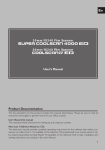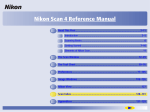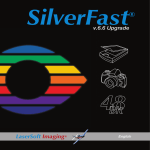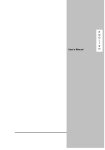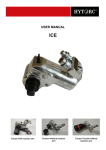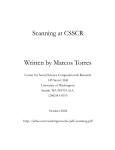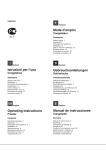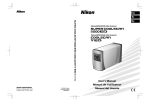Download Nikon Scan 3.1.4
Transcript
What is this? Nikon Scan version 3.1.4 for Macintosh OS X What is new/Content Description Support for Macintosh OS X Nikon Scan 3.1.4 is designed and written to support the Coolscan 8000 ED, Coolscan 4000 ED and the Coolscan IV ED scanners under Mac OS X. The LS-2000 and Coolscan III are NOT supported on Mac OS X. Compatible OS platform The new feature of Nikon View 3.1.4 is support for Macintosh OS X version 10.1.4 and higher as well as an Adobe Photoshop Scan plug-in. What's included in the download Nikon Scan 3.1.4 for Macintosh OS X Special Notes I. Known problems and issues with this release. Saving an image file to a network volume (All Mac OS) Nikon Scan 3.1.4 does not save an image file properly if the destination is a volume mounted over a network. A new file will be created, but this file will be corrupted. Please save your image files to your local hard disk first, and then move them to your network volume later on. PICT file cannot be opened (Mac OS X only) This release of Nikon Scan cannot open PICT format files although it saves files in PICT format correctly. System Sleep Issue (Mac OS X only) Please turn off the computer "Sleep" setting if you use LS-8000ED or LS- 4000ED. The computer may not awake correctly once it goes to the sleep mode. To turn Sleep off, select "System Preferences" from the Apple menu, and then click the "Energy Saver" icon that is listed in the "Hardware" column. Set the top slider to "Never" (all way to the right). Scratch Disk Issue (Mac OS X only) Regardless of the "Scratch Disk" setting of the Nikon Scan program, OS X is in full control of scratch disk selection. II. About Nikon Scan 3.1.4 In order to use the LCH editor and the Unsharp Mask Filter, the Color Management System must be active. Should you wish to enable the Color Management System (in order to make use of features that are only available through the Color Management System) yet prefer the appearance of a non-color managed file, it is possible to set the Calibrated RGB mode to ignore color space profiles and simply work with the original, untreated image. To set this mode, please follow the procedure below: 1. Open the Color Management tab of the Preference setting. 2. Turn on the "Nikon Color Management System" check box on the dialog. 3. Open the "RGB" tab. 4. Select the "Scanner RGB" for the calibrated RGB color. When Scanner RGB is selected, an ICC profile tag will not be embedded with the image file when the file is saved. 5. Quit Nikon Scan and launch again. Scan speed depends on the host computer processing speed and memory and may slow down when color management is on. Please note that in order to provide a more authentic "non-color managed" operational workflow: • • The image will not be compensated for the type of monitor in use. This compensation is normally applied when the Color Management System is turned on, however Nikon Scan will not apply the monitor compensation when "Scanner RGB" is selected, even if the color management system is turned on. An ICC profile tag will not be embedded in an image file when the file is saved. This tag is normally applied when the Color Management System is turned on, however Nikon Scan will not embed an ICC profile tag when the "Scanner RGB" is selected, even if the color management system is turned on. III. Using a SA-20, SA-21 Strip Film Adapter or SA-30 Roll Film Adapter The following sections describe tips for the SA-20, SA-21 and SA-30 film adapters. Frame Boundary Nikon Scan will automatically detect the edges of each frame. If, however, the Film Type setting is incorrect (e.g. Positive Film Type selected for a strip of negative images), this auto detect operation may not work properly. Please make sure that the Film Type is set correctly prior to performing any scans. Additionally, the thumbnail scan is an important step in aligning multiple frames for preview and main scans, and should be performed at least once prior to doing any preview scans or main scans. If it is not possible to perform a thumbnail scan, a preview scan should be performed as a minimum requirement. Frames with dark images or content can cause problems with frame edge detection. In this case, the thumbnail scan may give incorrect thumbnails. If the image appears to be offset, please use the "Adjust Boundary Offset" controls, located within the "Extras" tab, to change the scan offset. Continue to take preview scans until a satisfactory result is obtained. Differences between thumbnail images and preview images There is a slight difference between the thumbnail scan coverage area and the preview/main scan coverage area. As this is only a slight difference, there should be little or no consequences in the use of the scanner. When using a SA-21 Strip Film Adapter or a SA-30 Roll Film Adapter. The preview scan area, as well as the main scan area, covers slightly more area at the top and bottom of the images than the thumbnail scan area. When using a SA-20 Strip Film Adapter. The preview scan as well as the main scan area covers slightly less area at the top and bottom (when film is displayed vertically) of the images than the thumbnail scan area. Thumbnail display issue when using SA-30 Roll Film Adapter A thumbnail image for the 40th frame might not be displayed when using a filmstrip that contains 40 frames or more. Please consult the section called "scanning short, long or damaged film strips" in the User Manual. IV. Frame and Mask In order to cover the entire valid film area, the actual scanning area is larger than the film area in the holder. Because of this design, preview images and scanned images will always contain part of the frame or mask around the valid image area. Due to shape of the holders and mechanical tolerance of the masks, the valid image area may not be located in exactly the center of the preview or the scanned image. The frame may not always be consistent. V. Digital ROC/GEM limitation when using FH-816/FH8G1 holders Digital ROC and Digital GEM cannot be used when scanning 16mm film or microscope glass plates. Those functions will be disabled when using the FH-816 (16mm) and FH8G1 (medical slide) holders. VI. Multiple scanners This version of Nikon Scan 3 does not support multiple scanners. Please connect only one Nikon scanner at a time to the computer. VII. Hot plug operation Although USB and IEEE1394 interfaces are known as "Hot plug" interfaces that allow the insertion or removal of the interface cable without shutting down the computer, please do not do this when the scanner is in operation. If a powered-on scanner is connected to a powered-off computer, DO NOT turn on the computer on while the LED indicator located on the scanner panel is flashing slowly. Failure to comply with this requirement may cause unexpected problems with the scanner hardware. VIII. Switching the Nikon Color Management system It is necessary to quit and to re-launch Nikon Scan 3 after turning the Color Management System on or off for the change to take effect. IX. Making the most of available memory Please note following techniques that can be tried in order to minimize memory usage: • Reduce the number of preview images. Each preview takes up memory. • Use Calibrated RGB color space and avoid CMYK color space. CMYK has more channels and uses more memory. • When using the IA-20 (Advanced Photo System) adapter, do not use the thumbnail display, use the index print supplied with the developed film instead. • ICE3 (Digital ICE, ROC and GEM) requires additional memory and results in longer scan times. Turn these features off unless required. • Turn off the Nikon Color Management system. Nikon CMS takes memory to handle calibrated color spaces. Turn off and use RGB instead of Calibrated RGB or CMYK. X. Please note that Administrator rights are required to use Nikon Scan 3.1.4 in OS X




